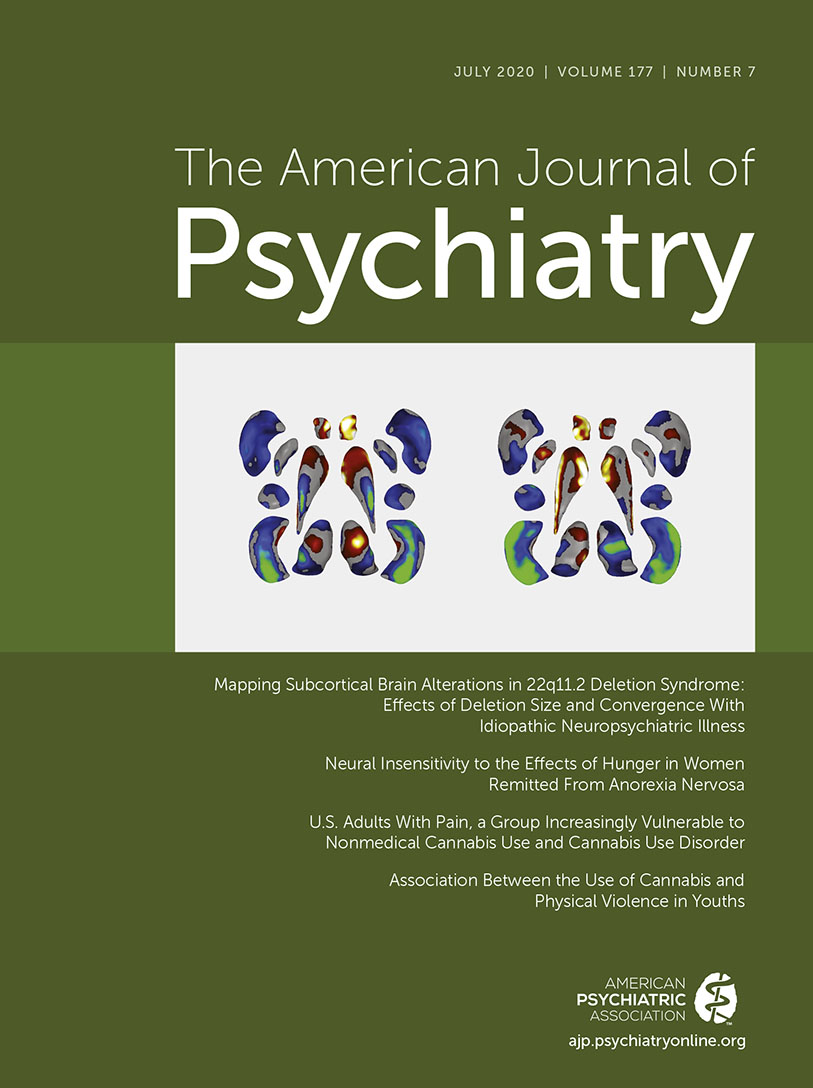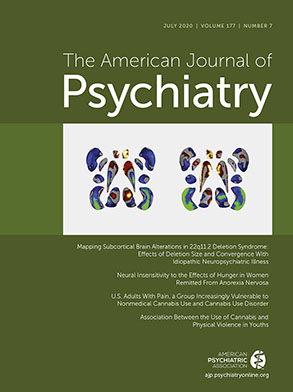Although a number of patients with anorexia nervosa—especially adolescents with relatively recent onset of the disorder—experience marked improvement and even remission after treatment, too many patients do not. Anorexia nervosa is characterized by low weight due to persistent efforts to restrict energy intake, often through the consumption of low-fat, low-calorie foods (
1). There is no U.S. Food and Drug Administration–approved medication for anorexia nervosa, and no medication has demonstrated substantial efficacy for both weight regain and the psychological symptoms of anorexia nervosa. Although it is more difficult to assess the absolute efficacy of nonpharmacological treatments for anorexia nervosa (e.g., nutritional rehabilitation in more intensive settings and/or psychotherapies), recent high-quality clinical trials comparing treatments make it clear that the majority of patients, especially adults, do not meet criteria for remission or recovery after treatment (
2).
Given the need for more efficacious interventions, repeated calls have been made to develop treatments targeting anorexia nervosa–specific mechanisms (
3), which would require an improved understanding of those mechanisms. In this issue of the
Journal, Kaye and colleagues advance this important inquiry by probing mechanisms related to the response to gustatory stimuli in varying metabolic states (
4). In healthy individuals, metabolic state modulates the reward salience of food in an adaptive fashion: fasting potentiates its subjective (reward) value, whereas satiation attenuates it. Kaye et al. used functional MRI to investigate whether this adaptive pattern is altered in women with remitted anorexia nervosa. Specifically, the authors examined how fed and fasted conditions affect blood-oxygen-level-dependent (BOLD) activation and functional connectivity in response to two tastants in women with remitted anorexia nervosa compared to women without a history of the disorder. Contrary to the expectation that the two tastants (a sucrose solution and ionic water) would exhibit different neural responses across conditions and groups, the pattern of results was similar for the two tastants. For both tastants together, two clusters within prespecified taste- and reward-related brain regions showed group differences in the pattern of activation across the fed and fasted conditions. In comparison women, the fasted condition was associated with a greater tastant-related increase in BOLD signal in two ventral caudal putamen clusters, consistent with adaptive potentiation of food reward when metabolic needs are more pressing. In women with remitted anorexia nervosa, the pattern was reversed, with the fed condition associated with the greater increase in BOLD signal in these two clusters. This opposing pattern of activation was also observed for tastant-related connectivity in one of the ventral caudal putamen clusters: in comparison women, this cluster had more positive correlations with seed regions in the right dorsal mid insula and the right ventral caudal putamen in the fasted condition versus the fed condition, whereas in women with remitted anorexia nervosa, these correlations were more positive in the fed condition. When looking at each condition separately, group differences were found for the fasted but not the fed condition: in the fasted condition, women with remitted anorexia nervosa were generally characterized by lower activation and less positive functional connectivity in response to tastants in the striatal regions. Interestingly, despite the groups’ opposing neural patterns across metabolic conditions, they reported highly similar subjective experiences of hunger and tastant pleasantness across the two conditions. In summary, despite similar ratings of hunger and tastant pleasantness in women with remitted anorexia nervosa, findings within the prespecified taste- and reward-related regions suggest smaller increases in tastant-related activation, and reduced tastant-related positive functional connectivity, in the fasted state for women with remitted anorexia nervosa. The authors suggest that the “reduced recruitment of the striatal aspects of this circuitry in response to tastants when hungry” may result in impaired “translation of taste reward value to motivated eating behavior,” representing a potential neural explanation for the persistent dietary restriction observed in anorexia nervosa.
The study by Kaye et al. addresses many of the challenges involved in advancing our understanding of the mechanisms underlying persistent dietary restriction in anorexia nervosa. One challenge is that starvation itself has strong effects, as demonstrated in the famed Minnesota Starvation Experiment conducted in healthy volunteers during World War II (
5). The choice to focus on women in remission from anorexia nervosa helps to mitigate the effects of starvation, which represent a potential confounder in studies of individuals with active anorexia nervosa. (Of course, as the authors note, even in a remitted sample, it is possible that alterations represent a “scar” of prior starvation or persistent low weight.) In addition, the investigators rigorously controlled eating behavior in the days prior to and during the experimental conditions, thereby reducing a potential source of variance and bias between groups. Several other aspects of the study also contributed to its rigor, including the focus on a sample free of psychoactive medications, control for menstrual phase, and confirmation that the findings were not unduly influenced by a lifetime history of major depression (which was present in over half of the remitted anorexia nervosa group). Finally, from a neuroscientific perspective, the prespecified taste- and reward-related regions of interest were well justified both by previous research on neural mechanisms implicated in motivation, salience, and valuation of food (
6) and by retrograde and anterograde tract tracing techniques in nonhuman primates that have elucidated structural connectivity of insula-striatal pathways that ultimately lead to the initiation of eating behavior (
7).
More research is needed to address the remaining complexities and to understand whether the intriguing findings from Kaye et al. represent a mechanism underlying persistent dietary restriction in anorexia nervosa. Specifically, future studies will need to establish whether reduced recruitment of striatal circuitry in response to passive taste in the fasted state translates into restrictive dietary choices in individuals who are not recovered from anorexia nervosa. Future research could focus on a weight-restored, but not fully recovered, sample to examine whether reduced recruitment of striatal circuitry in the fasted state is associated with a continued tendency toward choosing low-fat, low-calorie foods after treatment (
1) and/or is predictive of negative posttreatment trajectories.
If the alterations found by Kaye et al. do contribute to persistent dietary restriction in anorexia nervosa, future research will need to clarify the extent and etiology of these alterations in order to ameliorate them most effectively. First, one question is whether findings generalize to reward more broadly—that is, whether anorexia nervosa is also characterized by reduced recruitment of striatal circuitry in response to non-disorder-related reward stimuli in states typically associated with increased motivation for those rewards. In the present study, responses to water and the sucrose solution exhibited a similar pattern of reduced striatal recruitment among women remitted from anorexia nervosa in the fasted condition, which was characterized by greater thirst as well as greater hunger (not surprisingly, given that a significant portion of total water intake typically derives from food). Of course, water is arguably a disorder-related stimulus for some individuals with anorexia nervosa, who may exhibit markedly reduced or markedly elevated fluid intake for disorder-related reasons (
8). Among previous studies examining other types of reward (e.g., money), some but not all have found altered behavioral or striatal responses in anorexia nervosa (
9,
10). However, these studies have not typically systematically manipulated motivational state, and doing so might serve to clarify findings.
Second, as Kaye et al. acknowledge, future research will need to clarify whether reduced recruitment of striatal circuitry in response to tastants in the fasted state reflects the attenuation of “afferent metabolic signals that are translated into motivational behavior” or excessive modulation of those signals by “top-down modulatory brain regions.” With regard to the latter, cognitive factors can modulate activation in reward-related regions in response to gustatory stimuli (
11), and functional neuroimaging studies in anorexia nervosa have generally demonstrated increased activation in many of the cortical regions involved in that modulation (
10). Notably, neuromodulatory interventions targeting striatal or top-down modulatory regions have begun to be tested for treatment-resistant anorexia nervosa (
2,
12). Whether these—or pharmacological and psychological—interventions might address the alterations identified by Kaye et al. will require understanding whence these alterations arise.
Acknowledgments
Dr. Javaras’s research is supported by NIH grant K23DK120517 and the Eleanor and Miles Shore Harvard Medical School Fellowship. Dr. Pizzagalli was partially supported by NIH grant R37MH068376.

